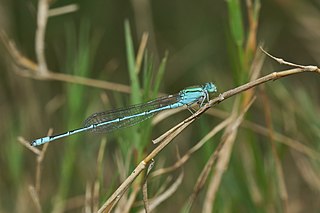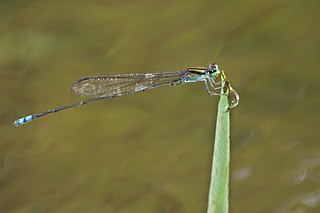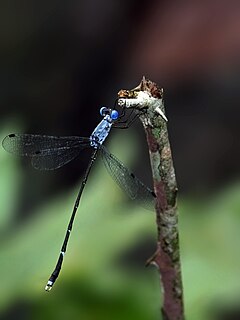
Ischnura senegalensis, also known variously as common bluetail, marsh bluetail, ubiquitous bluetail, African bluetail, and Senegal golden dartlet, is a widespread damselfly of the family Coenagrionidae. It is native from Africa, through the Middle East, to southern and eastern Asia.

Acisoma panorpoides, the Asian pintail, trumpet tail, or grizzled pintail, is a species of dragonfly in the family Libellulidae.

Copera vittata is a species of damselfly in the family Platycnemididae. It is native to Asia, where it is widely distributed from India to Indonesia. It is known commonly as the blue bush dart. There are several subspecies and it may represent a species complex.

Lestes elatus is a species of damselfly in the family Lestidae, the spreadwings. It is known commonly as the emerald spreadwing. It is native to India, Thailand and Sri Lanka.

Copera marginipes, yellow bush dart, is a species of damselfly in the family Platycnemididae. It is native to Asia, where it is widespread and common.

Aciagrion occidentale, green striped slender dartlet, is a species of damselfly in the family Coenagrionidae. It is found in India, Sri Lanka, Maldives, Vietnam and Thailand.

Amphiallagma parvum, little blue or azure dartlet, is a species of damselfly in the family Coenagrionidae. This species can be found in many South Asian countries including India, Sri Lanka, Myanmar, Thailand, Nepal, and probably in Bangladesh.

Paracercion malayanum, Malay lillysquatter, is a species of damselfly in the family Coenagrionidae. It is known to occur in India, Sri Lanka, Nepal, Java, Philippines and Thailand.

Pseudagrion malabaricum, Malabar sprite, jungle grass dart, is a species of damselfly in the family Coenagrionidae. It is found in India, Sri Lanka, and Myanmar.

Pseudagrion rubriceps, saffron-faced blue dart, is a species of damselfly in the family Coenagrionidae. It is found in many tropical Asian countries.

Pseudagrion decorum, elegant sprite or three striped blue dart, is a species of damselfly in the family Coenagrionidae. It is found in many tropical Asian countries.

Pseudagrion indicum, yellow-striped blue dart or yellow-striped dart, is a species of damselfly in the family Coenagrionidae. It is found only in Western Ghats of India.

Caconeura ramburi is a damselfly species in the family Platycnemididae. It is commonly known as the Coorg Bambootail or Indian blue bambootail. It is endemic to Western Ghats.

Caconeura gomphoides is a damselfly species in the family Platycnemididae. It is endemic to high altitude peat bogs and grassy uplands in Nilgiris.

Phylloneura westermanni, Myristica bambootail is a damselfly species in the family Platycnemididae. It is endemic to Myristica swamps of Western Ghats in India. The habitat is restricted to a few localities in Karnataka, Kerala and Tamil Nadu.

Esme cyaneovittata is damselfly in the family Platycnemididae. It is endemic to Western Ghats in India, south of Palakkad Gap.

Indosticta deccanensis, saffron reedtail is a damselfly species in the family Platystictidae. It is endemic to Western Ghats in India.

Lestes dorothea or Forest Spreadwing is a damselfly species in the family Lestidae. It is distributed from south and northeast India to Thailand and Malaysia.

Lestes patricia is a species of damselfly in the family Lestidae. It is native to Western Ghats in India.

Indolestes pulcherrimus is a species of spreadwing in the damselfly family Lestidae. The species was known only from in Kodagu district, Karnataka. Later it is found in forest swamps in Wayanad district, Kerala too.
























